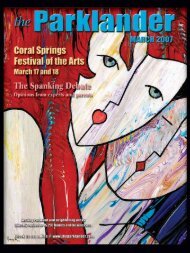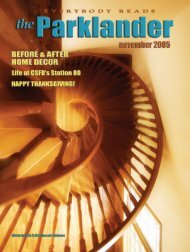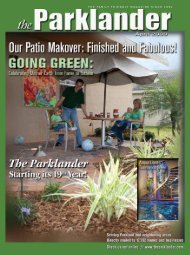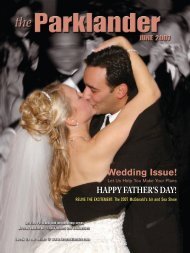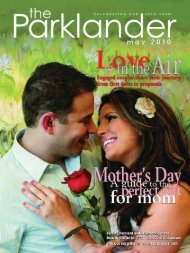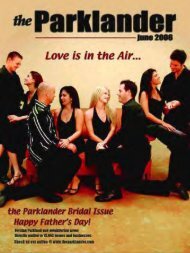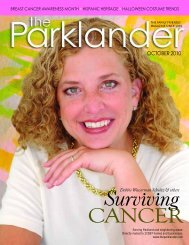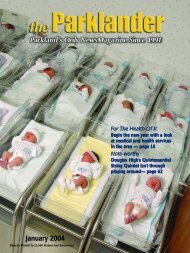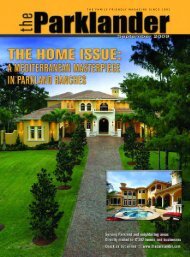February 2008 - The Parklander Magazine
February 2008 - The Parklander Magazine
February 2008 - The Parklander Magazine
- No tags were found...
You also want an ePaper? Increase the reach of your titles
YUMPU automatically turns print PDFs into web optimized ePapers that Google loves.
PET TALKWHENSurgeryIS THE BEST OPTION FOR YOUR PETBy Glenn Kalick, DVMSeven years ago a Toy Poodle namedCharlie was brought into my hospitalfor his first set of vaccines. Charlie wasbought at a local pet store and was thereplacement for a 15 year old yellowLabrador that died of cancer. It washard to say anything negative about thenew apple of the family’s eye butCharlie had “bilateral luxatingpatellas”. Luxating patellas is medicaljargon for “loose knee caps”.I finally got them to see an orthopaedicsurgeon after a painful incident whereCharlie was injured chasing a squirrel.<strong>The</strong> surgeon recommended surgerybefore the anterior cruciate ligament(ACL) ruptured. It was his opinion thatCharlie was going to tear the ligamentsometime in the next few years, soonerif he didn’t change his lifestyle. <strong>The</strong>family cancelled the surgery afterCharlie started feeling better.I did mention that the patella luxationwas documented on the healthcertificate by the Veterinarian who sawthe puppy at the pet store. Mrs. Vlooked curiously at Mr. V and wantedto know if he had seen it on the healthcertificate. Mr. V said that he did, butthought it was Spanish for having twotesticles. I reassured the family thatluxating patellas were very common inthis breed and as he matured he mightneed surgery. Because the family didn’tunderstand what the term actuallymeant and they were told that thecondition might worsen in the future,they were within their rights to returnthe puppy to the store due to the 30-day law. But within minutes of buyingthe puppy they were already in love, andthey were determined to keep him…<strong>The</strong> following three years were filled with numerous skin andgastrointestinal examinations. Charlie was a mischievous pup whoconstantly looked for things to entertain him.<strong>The</strong> family had a very largebackyard, which they left him in, frequently unsupervised. On more thanone occasion he was seen vomiting grass and mulch, got bit by a spider,and had an episode with a poisonous Bufo toad.Year four was the start of the leg injuries. <strong>The</strong> first time Charlie limped, thefamily rationalized that he jumped from the car.<strong>The</strong> second time they said itwas the sofa and the third time, it was the bed. <strong>The</strong> patellas were, in fact,starting to cause him discomfort.<strong>The</strong> constant rubbing of the patella on thefemur (leg bone) was starting to cause swelling, pain and the start ofdegenerative joint disease (DJD). Every time Charlie started to feel painthe family would give him a non-steroidal anti-inflammatory drug(NSAID) and that would usually help, but only temporarily.In the next five to seven years, glucosamine/chondroitin was added toCharlie’s diet for joint support. Upon physical examination, Charlie’sjoints would crack and crunch when flexed and extended, but he wouldn’tcomplain. <strong>The</strong> family would only treat Charlie with NSAIDS when hewas clinically in pain....within minutes of buyingthe puppy they were alreadyin love, and they weredetermined to keep him…In years eight through eleven the familyremarked to me that they were pleasedthat Charlie had managed to avoidsurgery all these years even though hecouldn’t jump on the couch and fatiguedafter a few blocks of a walk and nowneeded NSAIDS on a daily basis. Thatwas, until they got Damian.Damian was an energetic StandardPoodle puppy that within a week managedto help Charlie injure himselfirreparably by continuously chasinghim all over the house. Charlie wassoon brought into the hospital inexcruciating pain. He tore his ACLand his patella was completely luxatedand his joint was now swollen and red.<strong>The</strong> family asked me how muchmedication to give him. I told themthat the medication would help temporarily, but that he definitely neededsurgery. <strong>The</strong> family again didn’t agree, but after seven days, Charliecouldn’t even put his leg down. <strong>The</strong>y took him for alternative treatments,like massage and acupuncture, and the usually mild mannered Charliebecame frustrated at his appointment and bit the acupuncture physician.Frustrated and confused, the family came in to my office for a consultation.<strong>The</strong>y relayed that Charlie was on the best foods, glucosamines (oral andinjectable), NSAIDS, a morphine type drug for pain relief, but he still didn’twant to use his leg. <strong>The</strong>y wanted to know if I had any other options forthem. I said there was one more. I asked them whether or not they wantedto do it today or tomorrow. <strong>The</strong> eager family said today, Charlie couldn’twait another day; he was in too much pain. I left the room and came back inwith my surgeon.Most orthopaedic conditions can be made more tolerable with medication,but a surgical correction early on, as I had recommended, would definitelyhave benefited Charlie making his life much easier and happier.Glenn Kalick DVM is the owner of Brookside Animal Hospital in CoralSprings. Email him at kalick@theparklander.com.120 FEBRUARY <strong>2008</strong>



